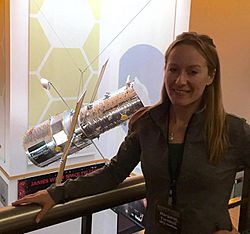Margaret Turnbull facts for kids
Quick facts for kids
Margaret Turnbull
|
|
|---|---|

At the Space Telescope Science Institute in 2016
|
|
| Nationality | American |
| Alma mater | University of Arizona |
| Known for | Planetary habitability |
| Scientific career | |
| Fields | Astronomy |
Margaret Carol "Maggie" Turnbull (born 1975) is an American astronomer and astrobiologist. She studied astronomy and earned her PhD from the University of Arizona in 2004. From 2001 to 2006, she worked with the Virtual Planetary Laboratory.
Dr. Turnbull is an expert on star systems that might have planets where life could exist. She also studies "solar twins" (stars like our Sun) and what makes a planet able to support life. She is skilled in using a special tool called a coronagraph. This tool helps scientists directly see planets orbiting other stars, called exoplanets.
Contents
Searching for Life in Space
The HabCat List
In 2002, Dr. Turnbull and fellow scientist Jill Tarter created something called HabCat. This is a list of star systems that might have planets suitable for life. The next year, she picked out 30 especially promising stars from the 5,000 on the HabCat list. These stars are all within 100 light years of Earth.
Top Star Candidates
In 2006, Dr. Turnbull made two shorter lists of just five stars each.
- The first list was used by the SETI Institute for radio searches using the Allen Telescope Array. These stars were Beta Canum Venaticorum, HD 10307, HD 211415, 18 Scorpii, and 51 Pegasi.
- The second list included her top choices for a future space telescope called the Terrestrial Planet Finder. These stars were Epsilon Indi, Epsilon Eridani, 40 Eridani, Alpha Centauri B, and Tau Ceti.
Continuing the Search
Dr. Turnbull's work is very important in the search for life beyond Earth. She often shares her ideas on how we define life and the best ways to find it. Her work with the HabCat list and her knowledge of coronagraphs have made her a strong supporter of missions that directly photograph exoplanets.
She was the Science Team Leader for the New Worlds Mission. In 2016, Dr. Turnbull became a leader for a team working on the Nancy Grace Roman Space Telescope. This telescope is designed to simulate mission data and choose targets for finding exoplanets directly. In 2017, she worked with Stephen Kane to figure out the possible mass of Proxima Centauri b. This is the closest exoplanet to our Solar System.
Asteroid Named in Her Honor
An asteroid named 7863 Turnbull was discovered by Brian A. Skiff in 1981. It was named after Dr. Turnbull to honor her contributions to astronomy. The official naming was announced on September 28, 1999.
Involvement in Politics
In 2018, Dr. Turnbull ran for the office of Governor of Wisconsin as an independent candidate. She ran with Wil Losch as her running mate. She received 18,779 votes and finished in fourth place.
See also
 In Spanish: Margaret Turnbull para niños
In Spanish: Margaret Turnbull para niños

